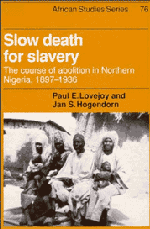Book contents
- Frontmatter
- Contents
- List of maps
- List of tables
- Preface
- 1 Slavery and the British conquest of Northern Nigeria
- 2 Fugitive slaves and the crisis in slavery policy
- 3 The debate on legal-status abolition
- 4 Emancipation and the law
- 5 Upholding proprietary rights to land
- 6 The role of taxation in the reform of slavery
- 7 The colonial economy and the slaves
- 8 The persistence of concubinage
- 9 Legal-status abolition: the final phase
- Appendix: Court records of slaves issued certificates of freedom
- Notes
- Glossary
- Bibliography
- Index
- Title in the series
8 - The persistence of concubinage
Published online by Cambridge University Press: 03 May 2011
- Frontmatter
- Contents
- List of maps
- List of tables
- Preface
- 1 Slavery and the British conquest of Northern Nigeria
- 2 Fugitive slaves and the crisis in slavery policy
- 3 The debate on legal-status abolition
- 4 Emancipation and the law
- 5 Upholding proprietary rights to land
- 6 The role of taxation in the reform of slavery
- 7 The colonial economy and the slaves
- 8 The persistence of concubinage
- 9 Legal-status abolition: the final phase
- Appendix: Court records of slaves issued certificates of freedom
- Notes
- Glossary
- Bibliography
- Index
- Title in the series
Summary
Most of the colonial measures that were designed to reform slavery and to promote its eventual demise were directed at men, as we have seen in the preceding chapters. Yet more than half of the slave population in the early colonial era appear to have been women. As we demonstrated in Chapter 4, issues relating to female slaves were considered to be variations on marital relationships. Women were either married, under the guardianship of relatives or other custodians, or an undesirable element in society that was associated with prostitution and crime. In this chapter, we explore the fate of female slaves after 1910, and more specifically how the institution of concubinage flourished in this period. It is our contention that concubinage presented one of the most persistent difficulties for British colonial policy towards slavery. Theoretically, concubinage resulted in the elimination of slave status for women, since concubines eventually became free. The free status of their children was legally protected even without the declaration that children born after March 31, 1901 were free. In fact, however, the demand for concubines continued, which meant that there had to be young women of servile status who could supply this demand. There were three sources of supply. Initially, females who had been born into slavery before 1901 were available; later girls who were legally free but of servile origin were pressed into concubinage; and finally the clandestine trade in children produced a steady stream of young girls.
- Type
- Chapter
- Information
- Slow Death for SlaveryThe Course of Abolition in Northern Nigeria 1897–1936, pp. 234 - 260Publisher: Cambridge University PressPrint publication year: 1993



